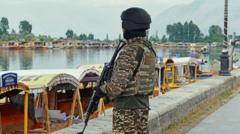
India and Pakistan Announce Immediate Ceasefire Agreement
Following days of escalating tensions and cross-border strikes, India and Pakistan have jointly announced a full and immediate ceasefire, effective immediately. The agreement aims to halt all firing along the Line of Control (LoC) and other sectors, offering a glimmer of hope for de-escalation after a period of heightened conflict.
Details of the Ceasefire Agreement
The joint statement, released simultaneously in New Delhi and Islamabad, indicates a mutual commitment to uphold the 2003 ceasefire agreement in letter and spirit. Key elements of the agreement include:
- Complete cessation of all firing by both sides, including artillery, small arms, and other weapons.
- Reinforcement of existing communication channels between military commanders on both sides to address any potential violations.
- Renewed commitment to resolve outstanding issues through peaceful dialogue and diplomatic channels.
- Regular flag meetings at designated points along the LoC to monitor the situation and prevent future escalations.
Reactions to the Announcement
The announcement has been met with cautious optimism from international observers and regional stakeholders. The United Nations Secretary-General has welcomed the ceasefire, calling it a "positive step" towards regional stability. Several countries have also issued statements expressing their support for the agreement and urging both sides to maintain restraint.
Within India and Pakistan, reactions have been mixed. While many have expressed relief at the prospect of peace, some have voiced concerns about the long-term sustainability of the agreement and the underlying issues that continue to fuel tensions.
Background to the Recent Escalation
The ceasefire follows a period of increased cross-border firing, reportedly resulting in casualties on both sides. Tensions have been particularly high in recent months, with each country accusing the other of violating the 2003 ceasefire agreement. Some factors contributing to the recent escalation include:
- Allegations of infiltration attempts by militants across the LoC.
- Disputes over border demarcations in certain sectors.
- Political rhetoric and heightened nationalist sentiment.
- Concerns related to the ongoing situation in Kashmir.
Looking Ahead: Challenges and Opportunities
While the ceasefire represents a significant step forward, it is crucial to recognize the challenges that remain. Sustaining peace will require consistent efforts from both sides to build trust, address underlying grievances, and foster a conducive environment for dialogue.
Opportunities exist to strengthen cooperation on various fronts, including:
- Enhancing communication and coordination between military personnel.
- Promoting confidence-building measures to reduce the risk of miscalculation.
- Engaging in people-to-people exchanges to foster greater understanding and empathy.
- Working together to combat terrorism and other common threats.
Expert Analysis
Analysts emphasize that the success of the ceasefire will depend on the willingness of both India and Pakistan to address the root causes of the conflict and to demonstrate genuine commitment to peaceful resolution. Long-term stability in the region requires a comprehensive approach that encompasses political, economic, and social dimensions.
Further monitoring and reporting will be provided as the situation develops.
